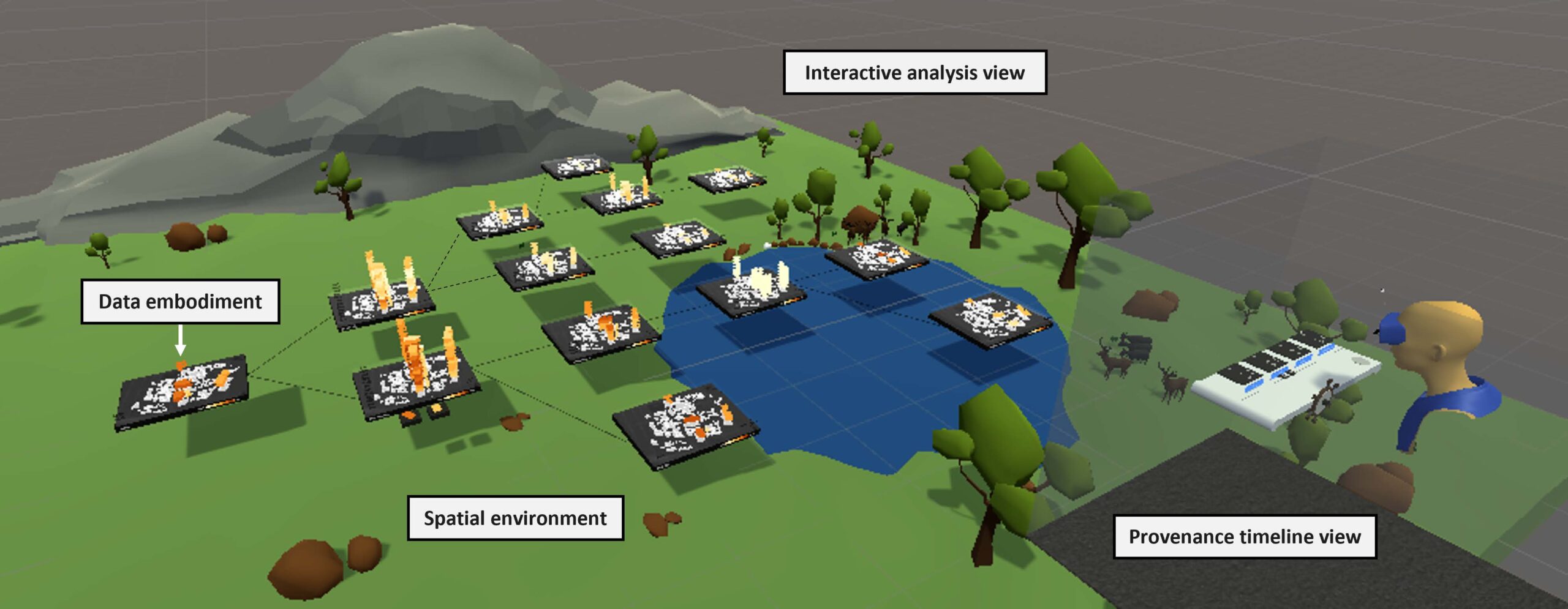Zhang, Y., Ens, B., Satriadi, K. A., Yang, Y., & Goodwin, S. (2023, April). Defining Embodied Provenance for Immersive Sensemaking. In Extended Abstracts of the 2023 CHI Conference on Human Factors in Computing Systems (pp. 1-7).
Defining Embodied Provenance for Immersive Sensemaking
Yidan Zhang, Barrett Ens, Kadek Ananta Satriadi, Ying Yang, Sarah Goodwin
CHI Conference on Human Factors in Computing Systems (Late-Breaking Work).
Hamburg, Germany.
2023.
This publication is student-led.

Immersive analytics research has explored how embodied data representations and interactions can be used to engage users in sensemaking. Prior research has broadly overlooked the potential of immersive space for supporting analytic provenance, the understanding of sensemaking processes through users’ interaction histories. We propose the concept of embodied provenance, the use of three-dimensional space and embodied interactions in supporting recalling, reproducing, annotating and sharing analysis history in immersive environments. We highlight a set of design criteria for analytic provenance drawn from prior work and propose a conceptual framework for embodied provenance. We develop a prototype system in virtual reality to demonstrate the concept and support the conceptual framework by providing multiple data views and embodied interaction metaphors in a large virtual space. We present a use case scenario of energy consumption analysis, which shows the system’s potential for assisting analytic provenance using embodiment.
DOI: https://doi.org/10.1145/3544549.3585691
Tags: analytics provenance,chi,embodied,late-breaking work
Related Publications
-
Active Proxy Dashboard: Binding Physical Referents and Abstract Data Representations in Situated Visualization through Tangible Interaction
Kadek Ananta Satriadi, Barrett Ens, Sarah Goodwin, Tim Dwyer -
Embodied Provenance for Immersive Sensemaking
Yidan Zhang, Barrett Ens, Kadek Ananta Satriadi, Ying Yang, Sarah Goodwin -
Strollytelling: Coupling Animation with Physical Locomotion to Explore Immersive Data Stories
Radhika Pankaj Jain, Adam Drogemuller, Kadek Ananta Satriadi, Ross Smith, Andrew Cunningham -
That's Rough! Encoding Data into Roughness for Physicalization
Xiaojiao Du, Kadek Ananta Satriadi, Adam Drogemuller, Brandon Matthews, Ross T. Smith, James Walsh, Andrew Cunningham -
ProxSituated Visualization: An Extended Model of Situated Visualization using Proxies for Physical Referents
Kadek Ananta Satriadi, Andrew Cunningham, Ross T. Smith, Tim Dwyer, Adam Drogemuller, Bruce H. Thomas -
User-Driven Constraints for Layout Optimisation in Augmented Reality
Aziz Niyazov, Barrett Ens, Kadek Ananta Satriadi, Nicolas Mellado, Loïc Barthe, Tim Dwyer, Marcos Serrano -
Tangible Globes for Data Visualisation in Augmented Reality
Kadek Ananta Satriadi, Jim Smiley, Barrett Ens, Maxime Cordeil, Tobias Czauderna, Benjamin Lee, Ying Yang, Tim Dwyer, Bernhard Jenny -
TimeTables: Embodied Exploration of Immersive Spatio-Temporal Data
Yidan Zhang, Barrett Ens, Kadek Ananta Satriadi, Arnaud Prouzeau, Sarah Goodwin -
Embodied Gesture Interaction for Immersive Maps
Rhys Newbury, Kadek Ananta Satriadi, Jesse Bolton, Jiazhou Liu, Maxime Cordeil, Arnaud Prouzeau, Bernhard Jenny -
Quantitative Data Visualisation on Virtual Globes
Kadek Ananta Satriadi, Barrett Ens, Tobias Czauderna, Maxime Cordeil, Bernhard Jenny